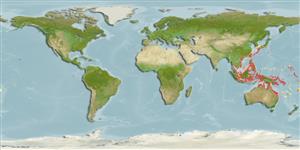Gastropoda |
Neogastropoda |
Nassariidae
Environment: milieu / climate zone / depth range / distribution range
Ecology
Benthic. Tropical
Northwest and Western Central Pacific: Hong Kong, Philippines, New Caledonia and Indonesia.
Length at first maturity / Size / Weight / Age
Maturity: Lm ? range ? - ? cm Max length : 2.5 cm ShH male/unsexed; (Ref. 821)
Length based on occurence record; to be replaced with better reference. Actively forages. Also feeds on dying invertebrates and fish carcasses (Ref. 115869). Found in sandy shore, near the vicinity of the depression formed during low tides to avoid desiccation (Ref. 125338).
Life cycle and mating behavior
Maturity | Reproduction | Spawning | Eggs | Fecundity | Larvae
This species is a non-broadcast spawner. Life cycle does not include trocophore stage. Also Ref. 833.
Springsteen, F.J. and F.M. Leobrera 1986 Shells of the Philippines. Carfel Seashell Museum. Metro Manila, Philippines. 377 p. (Ref. 821)
IUCN Red List Status
(Ref. 130435: Version 2025-1)
CITES status (Ref. 108899)
Not Evaluated
Not Evaluated
Threat to humans
Human uses
| FishSource |
Tools
More information
Population dynamicsGrowthMax. ages / sizesLength-weight rel.Length-length rel.Length-frequenciesMass conversionAbundance Life cycleReproductionMaturityFecunditySpawningEggsEgg developmentLarvae PhysiologyOxygen consumption
Human RelatedStamps, coins, misc.
Internet sources
Estimates based on models
Preferred temperature
(Ref.
115969): 24.6 - 29.3, mean 28.6 (based on 2104 cells).
Fishing Vulnerability
Low vulnerability (10 of 100).
